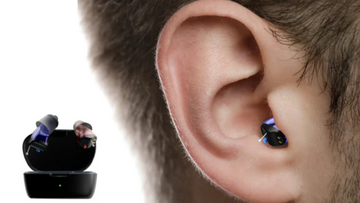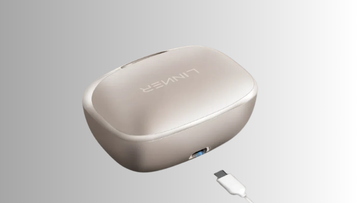When choosing the best hearing aid to reduce background noise, not every hearing aid is going to be the best. Most models amplify all sounds, background chatter, traffic, clinking of dishes, so you end up feeling frustrated and tired. However, the best hearing aids of 2025 will be different. With advances in microphone arrays, AI sound processing, and environment-adaptive algorithms, it’s now possible to effortlessly isolate voices with remarkable clarity, even in very noisy settings.
There are two models that are far ahead of the rest one being Linner Mars and Linner Saturn. Both provide the newest noise reduction technology, better than most of the competing models, and at the same time provide comfort, fashion, and ease of controls. Now, so what is the issue with background noise and how does modern technology help resolve it as well as what are the best otc hearing aids to maximize this impact?
Why Is Background Noise a Problem?
Background noise is not just an inconvenience to anyone with a hearing loss, it is an actual communication barrier. Just think of being in a crowded coffee shop and trying to have a conversation hearing all the hissing of espresso machines, scraping of the chairs, and the music in the background. Your hearing aid, without complex filtering, will pick up all of it, and your brain has to sort the mess.
The constant effort to sort through this audio clutter is exhausting and can make social situations feel overwhelming. This is why the best hearing aids to reduce background noise do not merely make the sounds louder but also render clearer speech making it consciously target the voices you would like to listen to and leaving all the others in the background.
Advanced Noise Reduction Technologies in Hearing Aids
The technology on the inner side of the current otc hearing aids is nothing but impressive. Multi-microphone arrays such as in the four-mic Linner Mars concentrate on all the sound in front of you and suppress all the rest. With a working unit of milliseconds, digital signal processors (DSP) recognize noise-speech patterns so that they can only amplify what is important.
Other usable functions in Linner equipment are wide dynamic range Compression (WDRC) that is able to tune multi-channel for exacting sounds, avoidance of an inconveniencing whistle sound by means of a feedback shield and operation of adapting sounds automatically to changing environments due to modification of listening settings. Whereas, there are simple directional microphones sold by certain competitors, they are generally not as precise and calibrated according to Linner specifications.
How Hearing Aids Reduce Background Noise
This mechanism starts with directional microphones recording sound that is in your atmosphere. By contrasting head facing sounds, the hearing aid sets the absolute perception of what to concentrate on, typically the voice that is before you. The DSP is from there the process allows to amplify speech frequencies and at the same time cut annoying sounds such as winds, traffic, or restaurant noise.
Top-tier ones, like Linner Mars, go a step further by employing the power of AI to learn your specific listening preferences over time. The more you use them, the more they adapt to your needs. This is to say the more you use them the more they learn your needs. However, most of the budget or mid-range models cannot have the processing power to make such fast and intelligent adjustments.

Recommended Best Background Noise Reduction Hearing Aids
1. Linner Mars
The Linner Mars is the gold standard in noise reduction for 2025. Its four high-performance microphones, sophisticated beamforming, and 18 WDRC channels all focus on speech and eliminate distractions with a gorgeous level of accuracy. It has Bluetooth 5.0 compatibility allowing you to listen to music and receive direct calls and once connected to the LINNER HA app, full customization is at your disposal.
One charge can go up to 8 hours governing an increase in battery life of 32 hours by the use of a charging case. The priority is comfort, and it means various different dome sizes, a safe seal, and IPX 5 water resistance to active lives. And the special Sound Therapy settings are there to aid in relaxation and sleep- something that most competitors cannot compete with.
2. Linner Saturn
If you want powerful performance with a discreet, nearly invisible design, there’s nothing quite like the Linner Saturn if you like your invisibility with performance. This mini-CIC hearing aids style gets way down into the ear canal, almost being microscopic. It is driven by an Onsemi™ chip, and with up to 16 WDRC channels (Saturn 2 version), it provides clean, natural, and superbly suppressed noise.
It has a battery life of 20-24 hours and the case stretches that to an amazing 96 hours. It lacks Bluetooth streaming, but centers on pure hearing capability, comfort, and discretion, which makes it ideal to those who desire the best noise reduction without technically being visible.
3. Audien Atom Pro
Audien Atom Pro is positioned as a cheap and inconspicuous model, whereas compared to Linner, it is not quite good at reducing the noise. It has a simple in-ear construction, lacks any directionality and a multi-microphone array. Although it is comfortable and light in weight, it is not good in places where there is a lot of activity, the voices and noise do overlap. The battery life is estimated at 16 hours; the ability to adjust is quite limited.
4. Otofonix Helix
The Otofonix Helix is a battery powered behind-the-ear (BTE) hearing aid which also boasts standard noise cancellation, though its larger size looks more conspicuous and less hidden in comparison to the CIC and ITE models produced by Linner. It muffles fairly well on medium noise, but does not hold to the facilitated beamforming and adapting software that makes Linner devices genius in really noisy environments. Battery life takes around 15 hours, and although it is cheap, it gives up on both style and high-level performance.
5. Lexie B2 Powered by Bose
The Lexie B2 is a good middle of the road model that has directional microphones and is controlled through an app, and has average performance in moderate noise. Nevertheless, it is not as accurate as multi-mic of Linner Mars or as fast in adapting to the processing process. It also has a battery lifetime of 18 hours and supports Bluetooth streaming which makes it attractive to technologically versatile individuals who do not require maximum noise reduction.
Comparison Table – Best Hearing Aid to Reduce Background Noise (2025)
|
Model |
Design Type |
Battery Life |
Special Features |
Best For |
|
Linner Mars |
ITE Earbud |
8 hrs (+24 case) |
4-mic beamforming, 18 WDRC channels, Bluetooth |
Active users, noisy settings |
|
Linner Saturn |
Mini CIC |
20–24 hrs (+96 case) |
Feedback Shield, Onsemi™ chip, ultra-discreet |
Discreet all-day wear |
|
Audien Atom Pro |
CIC |
16 hrs |
Budget-friendly, limited noise reduction |
Quiet settings, budget buyers |
|
Otofonix Helix |
BTE |
15 hrs |
Basic directional mics, rechargeable |
Casual users in mild noise |
|
Lexie B2 Powered by Bose |
RIC |
18 hrs |
Directional mics, Bluetooth |
Tech-savvy OTC buyers |
Tips for Maximizing Noise Reduction
Even the best hearing aid to reduce background noise is more effective when a couple of easy measures are used:
· Face your conversation partner and reduce background distractions when possible.
· Use directional listening modes for group settings or crowded venues.
· Keep your hearing aids clean and well-maintained for peak performance.
· Take advantage of app-based adjustments in real time to fine-tune your sound.

Conclusion
In case you are looking to buy the best hearing aid to reduce background noise, there is no greater option than Linner Mars and Linner Saturn in 2025. Equipped with unmatched microphone technology, enhanced sound processing, fusion of comfort and discretion in their designs makes them outperform previous products such as Audien Atom Pro, Otofonix Helix, Lexie B2 in the real-world noisy settings.
When you invest in Linner you are investing in the confidence of being able to enjoy life, in the ability to focus on good conversations, in the ability to listen a little longer with less listening strain.
Read more:






